Contract Law: Exclusion Clauses, Promissory Estoppel, and Terms
VerifiedAdded on 2022/09/15
|11
|1931
|19
Homework Assignment
AI Summary
This contract law assignment analyzes several key issues. Firstly, it determines whether a statement made during a sale constitutes a contract term or a mere representation, considering factors like written form, expertise of the speaker, importance to the buyer, and timing. Secondly, it examines the validity of an exclusion clause, assessing its incorporation through signature, notice, or prior dealings, and considering the contra proferentem rule. Thirdly, the assignment evaluates whether promissory estoppel can be applied, focusing on the absence of a pre-existing legal obligation. Finally, it determines the binding nature of a sticker's statement on future clients, emphasizing the need for incorporation into the contract either through signature or notice to be enforceable. The solution provides a detailed analysis of each issue, citing relevant case law and legal principles. A comprehensive bibliography of books, journals, and cases is included.
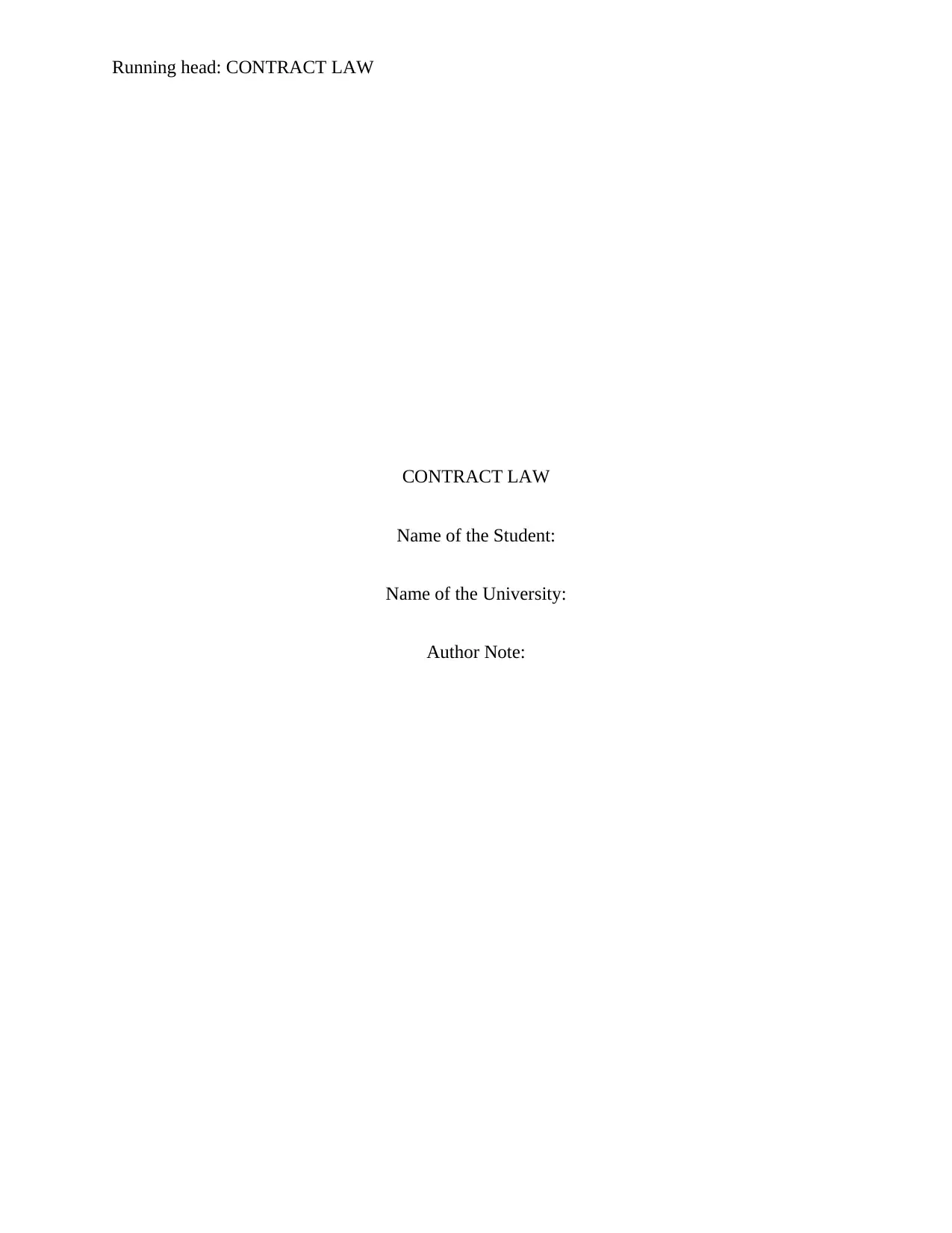
Running head: CONTRACT LAW
CONTRACT LAW
Name of the Student:
Name of the University:
Author Note:
CONTRACT LAW
Name of the Student:
Name of the University:
Author Note:
Paraphrase This Document
Need a fresh take? Get an instant paraphrase of this document with our AI Paraphraser
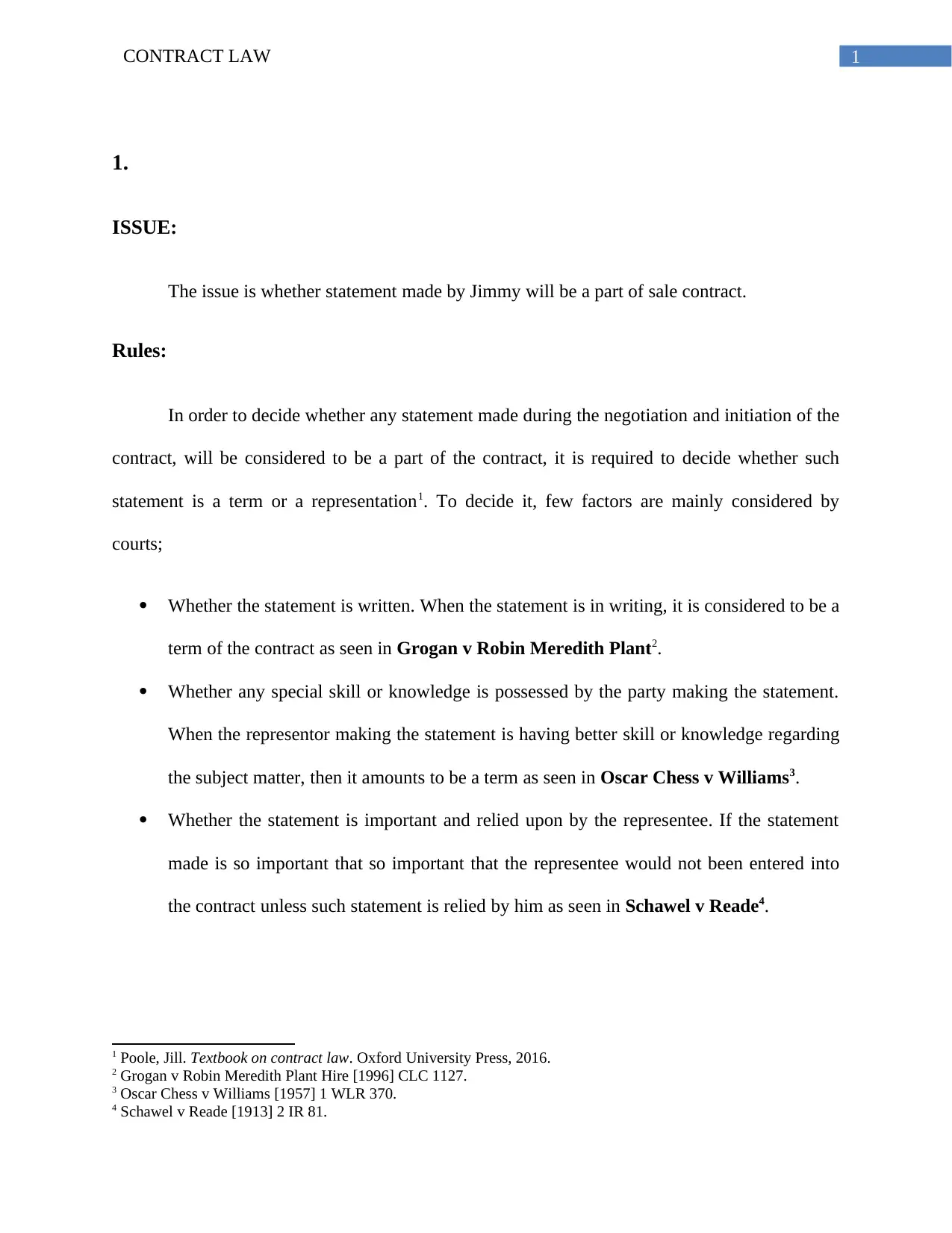
1CONTRACT LAW
1.
ISSUE:
The issue is whether statement made by Jimmy will be a part of sale contract.
Rules:
In order to decide whether any statement made during the negotiation and initiation of the
contract, will be considered to be a part of the contract, it is required to decide whether such
statement is a term or a representation1. To decide it, few factors are mainly considered by
courts;
Whether the statement is written. When the statement is in writing, it is considered to be a
term of the contract as seen in Grogan v Robin Meredith Plant2.
Whether any special skill or knowledge is possessed by the party making the statement.
When the representor making the statement is having better skill or knowledge regarding
the subject matter, then it amounts to be a term as seen in Oscar Chess v Williams3.
Whether the statement is important and relied upon by the representee. If the statement
made is so important that so important that the representee would not been entered into
the contract unless such statement is relied by him as seen in Schawel v Reade4.
1 Poole, Jill. Textbook on contract law. Oxford University Press, 2016.
2 Grogan v Robin Meredith Plant Hire [1996] CLC 1127.
3 Oscar Chess v Williams [1957] 1 WLR 370.
4 Schawel v Reade [1913] 2 IR 81.
1.
ISSUE:
The issue is whether statement made by Jimmy will be a part of sale contract.
Rules:
In order to decide whether any statement made during the negotiation and initiation of the
contract, will be considered to be a part of the contract, it is required to decide whether such
statement is a term or a representation1. To decide it, few factors are mainly considered by
courts;
Whether the statement is written. When the statement is in writing, it is considered to be a
term of the contract as seen in Grogan v Robin Meredith Plant2.
Whether any special skill or knowledge is possessed by the party making the statement.
When the representor making the statement is having better skill or knowledge regarding
the subject matter, then it amounts to be a term as seen in Oscar Chess v Williams3.
Whether the statement is important and relied upon by the representee. If the statement
made is so important that so important that the representee would not been entered into
the contract unless such statement is relied by him as seen in Schawel v Reade4.
1 Poole, Jill. Textbook on contract law. Oxford University Press, 2016.
2 Grogan v Robin Meredith Plant Hire [1996] CLC 1127.
3 Oscar Chess v Williams [1957] 1 WLR 370.
4 Schawel v Reade [1913] 2 IR 81.
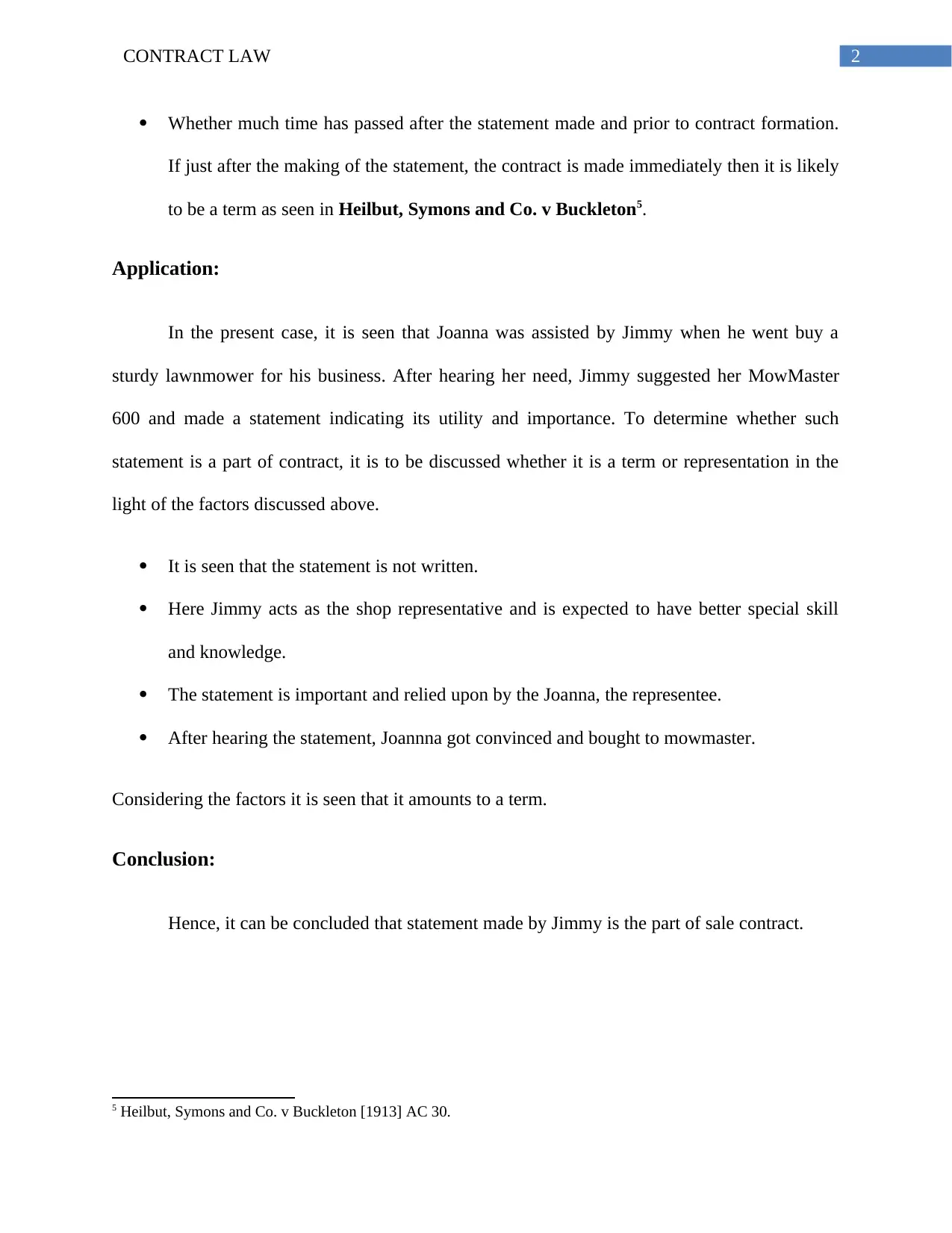
2CONTRACT LAW
Whether much time has passed after the statement made and prior to contract formation.
If just after the making of the statement, the contract is made immediately then it is likely
to be a term as seen in Heilbut, Symons and Co. v Buckleton5.
Application:
In the present case, it is seen that Joanna was assisted by Jimmy when he went buy a
sturdy lawnmower for his business. After hearing her need, Jimmy suggested her MowMaster
600 and made a statement indicating its utility and importance. To determine whether such
statement is a part of contract, it is to be discussed whether it is a term or representation in the
light of the factors discussed above.
It is seen that the statement is not written.
Here Jimmy acts as the shop representative and is expected to have better special skill
and knowledge.
The statement is important and relied upon by the Joanna, the representee.
After hearing the statement, Joannna got convinced and bought to mowmaster.
Considering the factors it is seen that it amounts to a term.
Conclusion:
Hence, it can be concluded that statement made by Jimmy is the part of sale contract.
5 Heilbut, Symons and Co. v Buckleton [1913] AC 30.
Whether much time has passed after the statement made and prior to contract formation.
If just after the making of the statement, the contract is made immediately then it is likely
to be a term as seen in Heilbut, Symons and Co. v Buckleton5.
Application:
In the present case, it is seen that Joanna was assisted by Jimmy when he went buy a
sturdy lawnmower for his business. After hearing her need, Jimmy suggested her MowMaster
600 and made a statement indicating its utility and importance. To determine whether such
statement is a part of contract, it is to be discussed whether it is a term or representation in the
light of the factors discussed above.
It is seen that the statement is not written.
Here Jimmy acts as the shop representative and is expected to have better special skill
and knowledge.
The statement is important and relied upon by the Joanna, the representee.
After hearing the statement, Joannna got convinced and bought to mowmaster.
Considering the factors it is seen that it amounts to a term.
Conclusion:
Hence, it can be concluded that statement made by Jimmy is the part of sale contract.
5 Heilbut, Symons and Co. v Buckleton [1913] AC 30.
⊘ This is a preview!⊘
Do you want full access?
Subscribe today to unlock all pages.

Trusted by 1+ million students worldwide
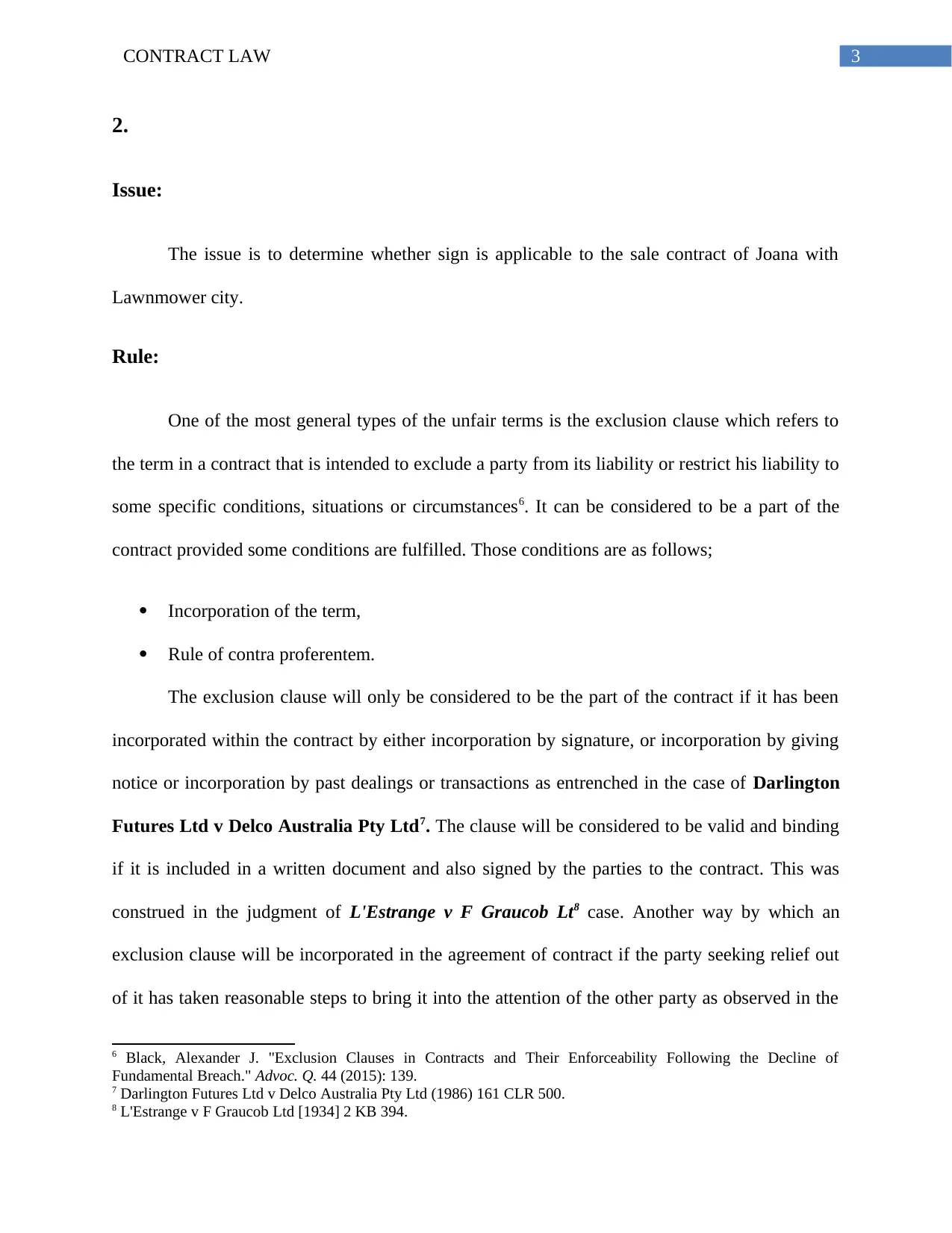
3CONTRACT LAW
2.
Issue:
The issue is to determine whether sign is applicable to the sale contract of Joana with
Lawnmower city.
Rule:
One of the most general types of the unfair terms is the exclusion clause which refers to
the term in a contract that is intended to exclude a party from its liability or restrict his liability to
some specific conditions, situations or circumstances6. It can be considered to be a part of the
contract provided some conditions are fulfilled. Those conditions are as follows;
Incorporation of the term,
Rule of contra proferentem.
The exclusion clause will only be considered to be the part of the contract if it has been
incorporated within the contract by either incorporation by signature, or incorporation by giving
notice or incorporation by past dealings or transactions as entrenched in the case of Darlington
Futures Ltd v Delco Australia Pty Ltd7. The clause will be considered to be valid and binding
if it is included in a written document and also signed by the parties to the contract. This was
construed in the judgment of L'Estrange v F Graucob Lt8 case. Another way by which an
exclusion clause will be incorporated in the agreement of contract if the party seeking relief out
of it has taken reasonable steps to bring it into the attention of the other party as observed in the
6 Black, Alexander J. "Exclusion Clauses in Contracts and Their Enforceability Following the Decline of
Fundamental Breach." Advoc. Q. 44 (2015): 139.
7 Darlington Futures Ltd v Delco Australia Pty Ltd (1986) 161 CLR 500.
8 L'Estrange v F Graucob Ltd [1934] 2 KB 394.
2.
Issue:
The issue is to determine whether sign is applicable to the sale contract of Joana with
Lawnmower city.
Rule:
One of the most general types of the unfair terms is the exclusion clause which refers to
the term in a contract that is intended to exclude a party from its liability or restrict his liability to
some specific conditions, situations or circumstances6. It can be considered to be a part of the
contract provided some conditions are fulfilled. Those conditions are as follows;
Incorporation of the term,
Rule of contra proferentem.
The exclusion clause will only be considered to be the part of the contract if it has been
incorporated within the contract by either incorporation by signature, or incorporation by giving
notice or incorporation by past dealings or transactions as entrenched in the case of Darlington
Futures Ltd v Delco Australia Pty Ltd7. The clause will be considered to be valid and binding
if it is included in a written document and also signed by the parties to the contract. This was
construed in the judgment of L'Estrange v F Graucob Lt8 case. Another way by which an
exclusion clause will be incorporated in the agreement of contract if the party seeking relief out
of it has taken reasonable steps to bring it into the attention of the other party as observed in the
6 Black, Alexander J. "Exclusion Clauses in Contracts and Their Enforceability Following the Decline of
Fundamental Breach." Advoc. Q. 44 (2015): 139.
7 Darlington Futures Ltd v Delco Australia Pty Ltd (1986) 161 CLR 500.
8 L'Estrange v F Graucob Ltd [1934] 2 KB 394.
Paraphrase This Document
Need a fresh take? Get an instant paraphrase of this document with our AI Paraphraser
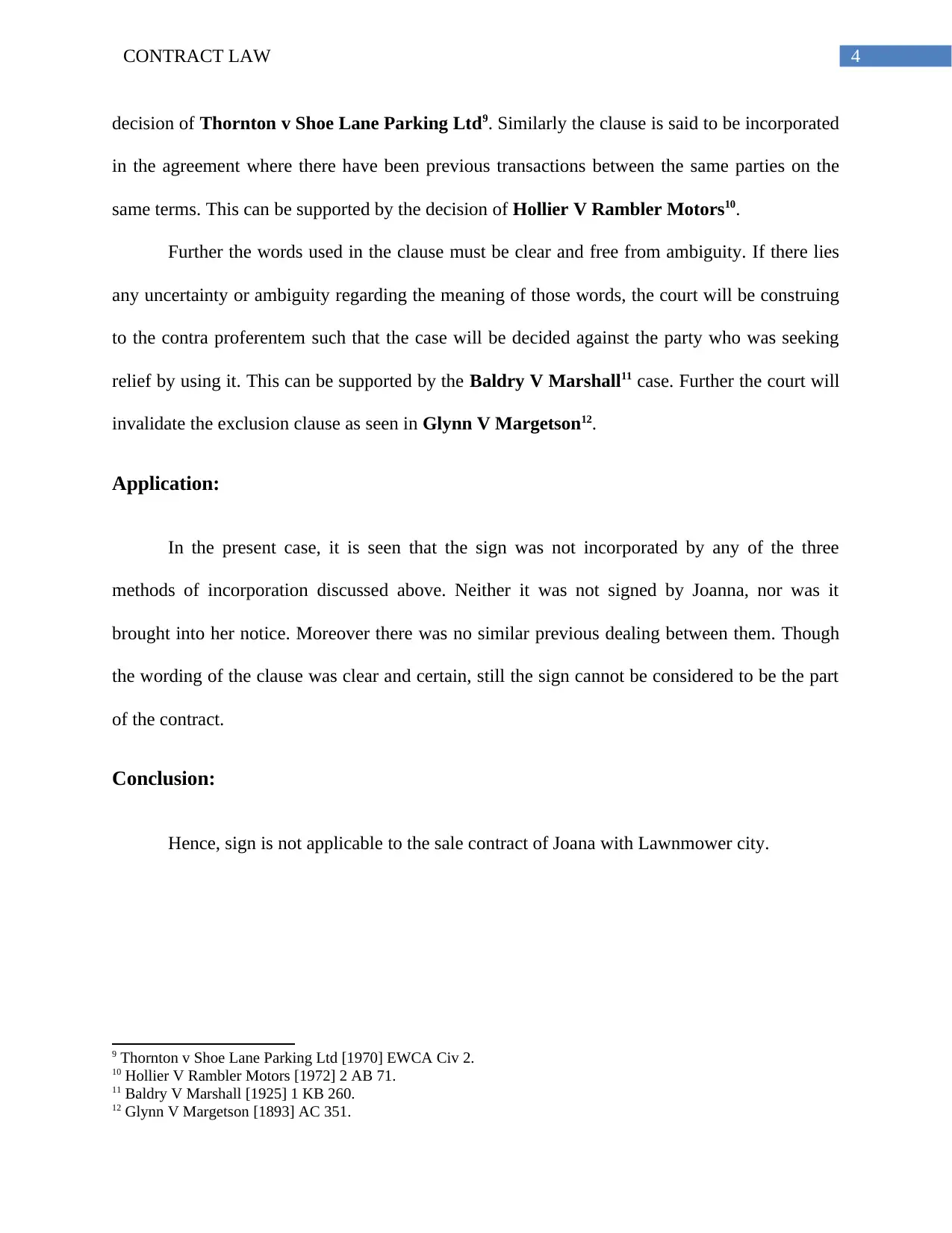
4CONTRACT LAW
decision of Thornton v Shoe Lane Parking Ltd9. Similarly the clause is said to be incorporated
in the agreement where there have been previous transactions between the same parties on the
same terms. This can be supported by the decision of Hollier V Rambler Motors10.
Further the words used in the clause must be clear and free from ambiguity. If there lies
any uncertainty or ambiguity regarding the meaning of those words, the court will be construing
to the contra proferentem such that the case will be decided against the party who was seeking
relief by using it. This can be supported by the Baldry V Marshall11 case. Further the court will
invalidate the exclusion clause as seen in Glynn V Margetson12.
Application:
In the present case, it is seen that the sign was not incorporated by any of the three
methods of incorporation discussed above. Neither it was not signed by Joanna, nor was it
brought into her notice. Moreover there was no similar previous dealing between them. Though
the wording of the clause was clear and certain, still the sign cannot be considered to be the part
of the contract.
Conclusion:
Hence, sign is not applicable to the sale contract of Joana with Lawnmower city.
9 Thornton v Shoe Lane Parking Ltd [1970] EWCA Civ 2.
10 Hollier V Rambler Motors [1972] 2 AB 71.
11 Baldry V Marshall [1925] 1 KB 260.
12 Glynn V Margetson [1893] AC 351.
decision of Thornton v Shoe Lane Parking Ltd9. Similarly the clause is said to be incorporated
in the agreement where there have been previous transactions between the same parties on the
same terms. This can be supported by the decision of Hollier V Rambler Motors10.
Further the words used in the clause must be clear and free from ambiguity. If there lies
any uncertainty or ambiguity regarding the meaning of those words, the court will be construing
to the contra proferentem such that the case will be decided against the party who was seeking
relief by using it. This can be supported by the Baldry V Marshall11 case. Further the court will
invalidate the exclusion clause as seen in Glynn V Margetson12.
Application:
In the present case, it is seen that the sign was not incorporated by any of the three
methods of incorporation discussed above. Neither it was not signed by Joanna, nor was it
brought into her notice. Moreover there was no similar previous dealing between them. Though
the wording of the clause was clear and certain, still the sign cannot be considered to be the part
of the contract.
Conclusion:
Hence, sign is not applicable to the sale contract of Joana with Lawnmower city.
9 Thornton v Shoe Lane Parking Ltd [1970] EWCA Civ 2.
10 Hollier V Rambler Motors [1972] 2 AB 71.
11 Baldry V Marshall [1925] 1 KB 260.
12 Glynn V Margetson [1893] AC 351.
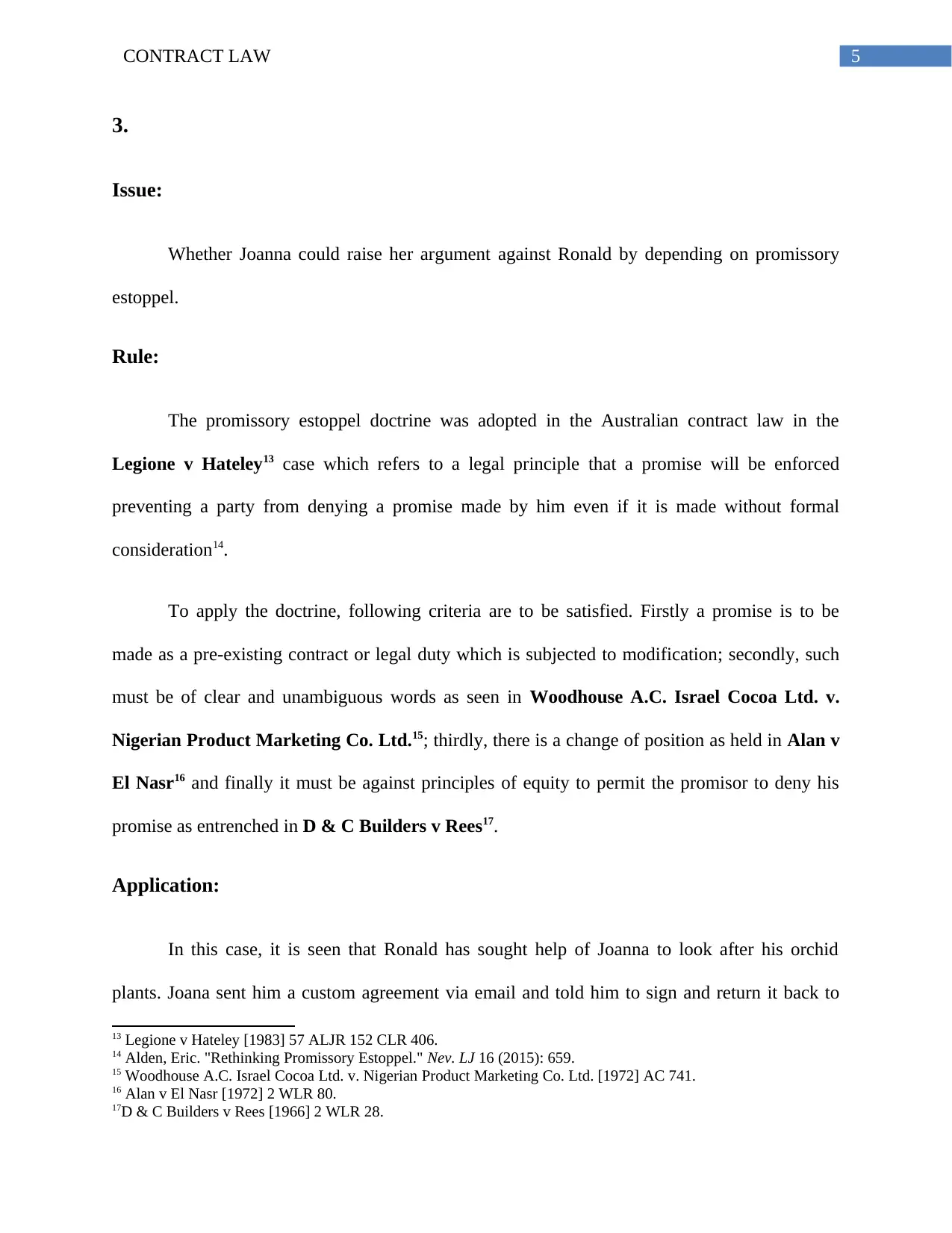
5CONTRACT LAW
3.
Issue:
Whether Joanna could raise her argument against Ronald by depending on promissory
estoppel.
Rule:
The promissory estoppel doctrine was adopted in the Australian contract law in the
Legione v Hateley13 case which refers to a legal principle that a promise will be enforced
preventing a party from denying a promise made by him even if it is made without formal
consideration14.
To apply the doctrine, following criteria are to be satisfied. Firstly a promise is to be
made as a pre-existing contract or legal duty which is subjected to modification; secondly, such
must be of clear and unambiguous words as seen in Woodhouse A.C. Israel Cocoa Ltd. v.
Nigerian Product Marketing Co. Ltd.15; thirdly, there is a change of position as held in Alan v
El Nasr16 and finally it must be against principles of equity to permit the promisor to deny his
promise as entrenched in D & C Builders v Rees17.
Application:
In this case, it is seen that Ronald has sought help of Joanna to look after his orchid
plants. Joana sent him a custom agreement via email and told him to sign and return it back to
13 Legione v Hateley [1983] 57 ALJR 152 CLR 406.
14 Alden, Eric. "Rethinking Promissory Estoppel." Nev. LJ 16 (2015): 659.
15 Woodhouse A.C. Israel Cocoa Ltd. v. Nigerian Product Marketing Co. Ltd. [1972] AC 741.
16 Alan v El Nasr [1972] 2 WLR 80.
17D & C Builders v Rees [1966] 2 WLR 28.
3.
Issue:
Whether Joanna could raise her argument against Ronald by depending on promissory
estoppel.
Rule:
The promissory estoppel doctrine was adopted in the Australian contract law in the
Legione v Hateley13 case which refers to a legal principle that a promise will be enforced
preventing a party from denying a promise made by him even if it is made without formal
consideration14.
To apply the doctrine, following criteria are to be satisfied. Firstly a promise is to be
made as a pre-existing contract or legal duty which is subjected to modification; secondly, such
must be of clear and unambiguous words as seen in Woodhouse A.C. Israel Cocoa Ltd. v.
Nigerian Product Marketing Co. Ltd.15; thirdly, there is a change of position as held in Alan v
El Nasr16 and finally it must be against principles of equity to permit the promisor to deny his
promise as entrenched in D & C Builders v Rees17.
Application:
In this case, it is seen that Ronald has sought help of Joanna to look after his orchid
plants. Joana sent him a custom agreement via email and told him to sign and return it back to
13 Legione v Hateley [1983] 57 ALJR 152 CLR 406.
14 Alden, Eric. "Rethinking Promissory Estoppel." Nev. LJ 16 (2015): 659.
15 Woodhouse A.C. Israel Cocoa Ltd. v. Nigerian Product Marketing Co. Ltd. [1972] AC 741.
16 Alan v El Nasr [1972] 2 WLR 80.
17D & C Builders v Rees [1966] 2 WLR 28.
⊘ This is a preview!⊘
Do you want full access?
Subscribe today to unlock all pages.

Trusted by 1+ million students worldwide
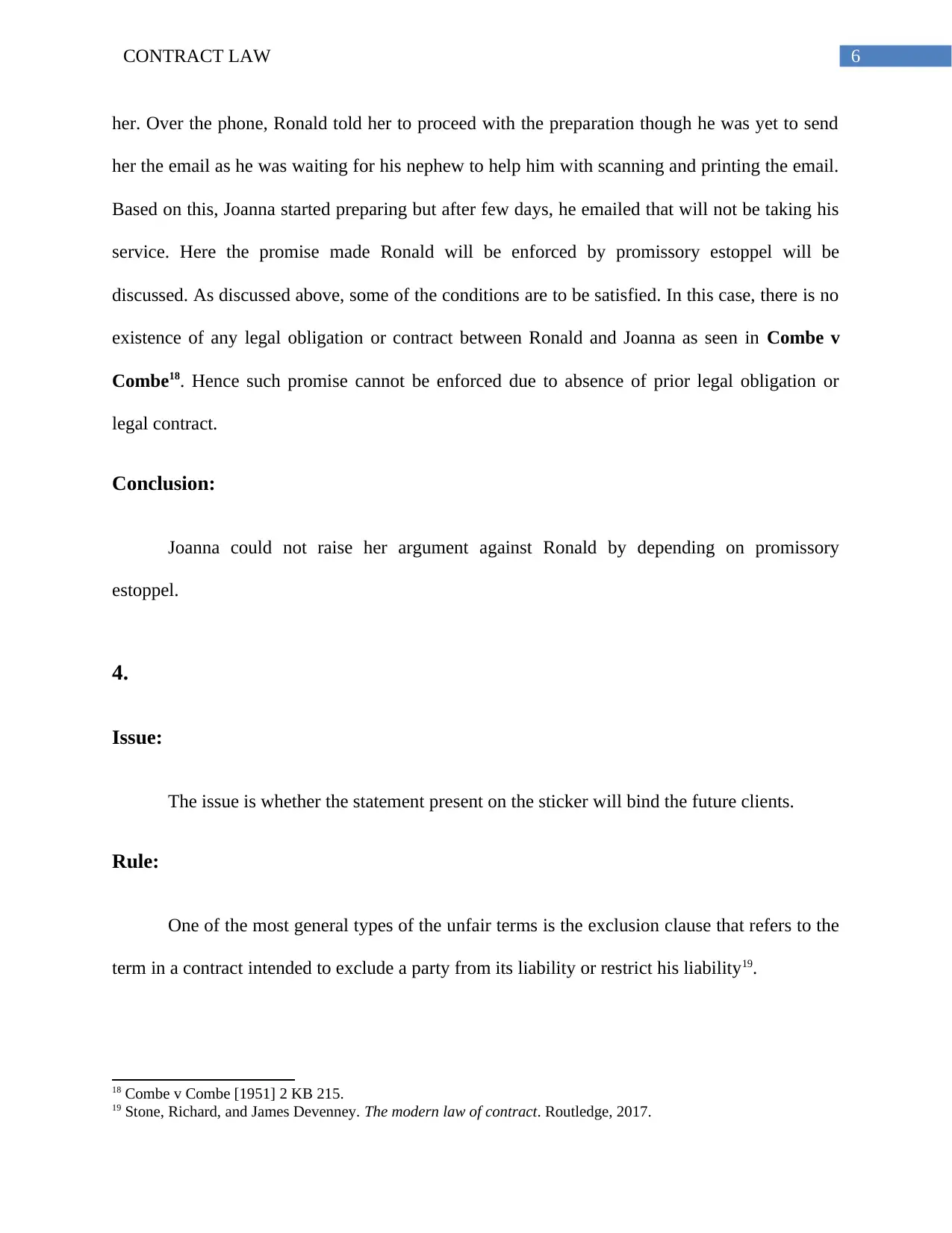
6CONTRACT LAW
her. Over the phone, Ronald told her to proceed with the preparation though he was yet to send
her the email as he was waiting for his nephew to help him with scanning and printing the email.
Based on this, Joanna started preparing but after few days, he emailed that will not be taking his
service. Here the promise made Ronald will be enforced by promissory estoppel will be
discussed. As discussed above, some of the conditions are to be satisfied. In this case, there is no
existence of any legal obligation or contract between Ronald and Joanna as seen in Combe v
Combe18. Hence such promise cannot be enforced due to absence of prior legal obligation or
legal contract.
Conclusion:
Joanna could not raise her argument against Ronald by depending on promissory
estoppel.
4.
Issue:
The issue is whether the statement present on the sticker will bind the future clients.
Rule:
One of the most general types of the unfair terms is the exclusion clause that refers to the
term in a contract intended to exclude a party from its liability or restrict his liability19.
18 Combe v Combe [1951] 2 KB 215.
19 Stone, Richard, and James Devenney. The modern law of contract. Routledge, 2017.
her. Over the phone, Ronald told her to proceed with the preparation though he was yet to send
her the email as he was waiting for his nephew to help him with scanning and printing the email.
Based on this, Joanna started preparing but after few days, he emailed that will not be taking his
service. Here the promise made Ronald will be enforced by promissory estoppel will be
discussed. As discussed above, some of the conditions are to be satisfied. In this case, there is no
existence of any legal obligation or contract between Ronald and Joanna as seen in Combe v
Combe18. Hence such promise cannot be enforced due to absence of prior legal obligation or
legal contract.
Conclusion:
Joanna could not raise her argument against Ronald by depending on promissory
estoppel.
4.
Issue:
The issue is whether the statement present on the sticker will bind the future clients.
Rule:
One of the most general types of the unfair terms is the exclusion clause that refers to the
term in a contract intended to exclude a party from its liability or restrict his liability19.
18 Combe v Combe [1951] 2 KB 215.
19 Stone, Richard, and James Devenney. The modern law of contract. Routledge, 2017.
Paraphrase This Document
Need a fresh take? Get an instant paraphrase of this document with our AI Paraphraser
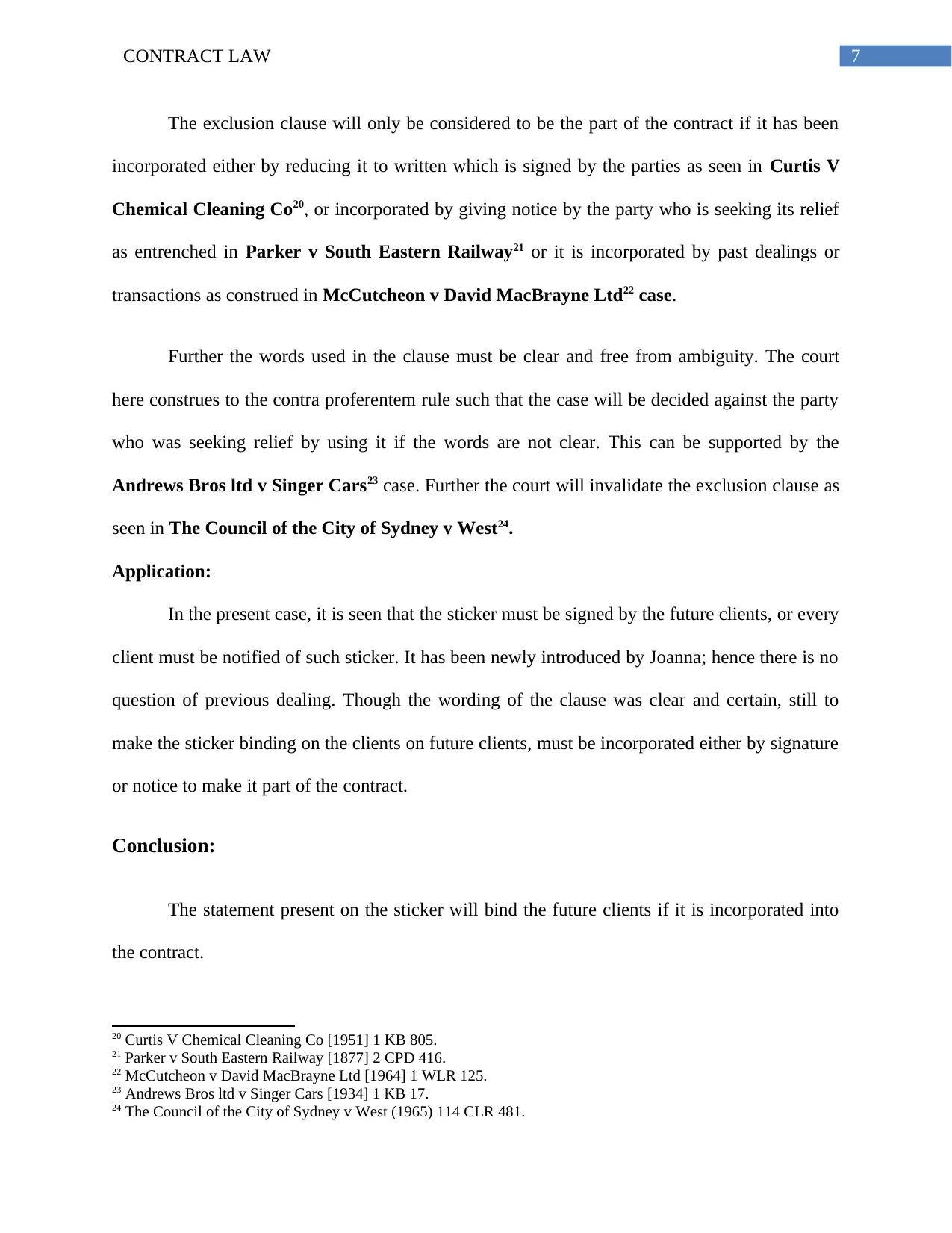
7CONTRACT LAW
The exclusion clause will only be considered to be the part of the contract if it has been
incorporated either by reducing it to written which is signed by the parties as seen in Curtis V
Chemical Cleaning Co20, or incorporated by giving notice by the party who is seeking its relief
as entrenched in Parker v South Eastern Railway21 or it is incorporated by past dealings or
transactions as construed in McCutcheon v David MacBrayne Ltd22 case.
Further the words used in the clause must be clear and free from ambiguity. The court
here construes to the contra proferentem rule such that the case will be decided against the party
who was seeking relief by using it if the words are not clear. This can be supported by the
Andrews Bros ltd v Singer Cars23 case. Further the court will invalidate the exclusion clause as
seen in The Council of the City of Sydney v West24.
Application:
In the present case, it is seen that the sticker must be signed by the future clients, or every
client must be notified of such sticker. It has been newly introduced by Joanna; hence there is no
question of previous dealing. Though the wording of the clause was clear and certain, still to
make the sticker binding on the clients on future clients, must be incorporated either by signature
or notice to make it part of the contract.
Conclusion:
The statement present on the sticker will bind the future clients if it is incorporated into
the contract.
20 Curtis V Chemical Cleaning Co [1951] 1 KB 805.
21 Parker v South Eastern Railway [1877] 2 CPD 416.
22 McCutcheon v David MacBrayne Ltd [1964] 1 WLR 125.
23 Andrews Bros ltd v Singer Cars [1934] 1 KB 17.
24 The Council of the City of Sydney v West (1965) 114 CLR 481.
The exclusion clause will only be considered to be the part of the contract if it has been
incorporated either by reducing it to written which is signed by the parties as seen in Curtis V
Chemical Cleaning Co20, or incorporated by giving notice by the party who is seeking its relief
as entrenched in Parker v South Eastern Railway21 or it is incorporated by past dealings or
transactions as construed in McCutcheon v David MacBrayne Ltd22 case.
Further the words used in the clause must be clear and free from ambiguity. The court
here construes to the contra proferentem rule such that the case will be decided against the party
who was seeking relief by using it if the words are not clear. This can be supported by the
Andrews Bros ltd v Singer Cars23 case. Further the court will invalidate the exclusion clause as
seen in The Council of the City of Sydney v West24.
Application:
In the present case, it is seen that the sticker must be signed by the future clients, or every
client must be notified of such sticker. It has been newly introduced by Joanna; hence there is no
question of previous dealing. Though the wording of the clause was clear and certain, still to
make the sticker binding on the clients on future clients, must be incorporated either by signature
or notice to make it part of the contract.
Conclusion:
The statement present on the sticker will bind the future clients if it is incorporated into
the contract.
20 Curtis V Chemical Cleaning Co [1951] 1 KB 805.
21 Parker v South Eastern Railway [1877] 2 CPD 416.
22 McCutcheon v David MacBrayne Ltd [1964] 1 WLR 125.
23 Andrews Bros ltd v Singer Cars [1934] 1 KB 17.
24 The Council of the City of Sydney v West (1965) 114 CLR 481.
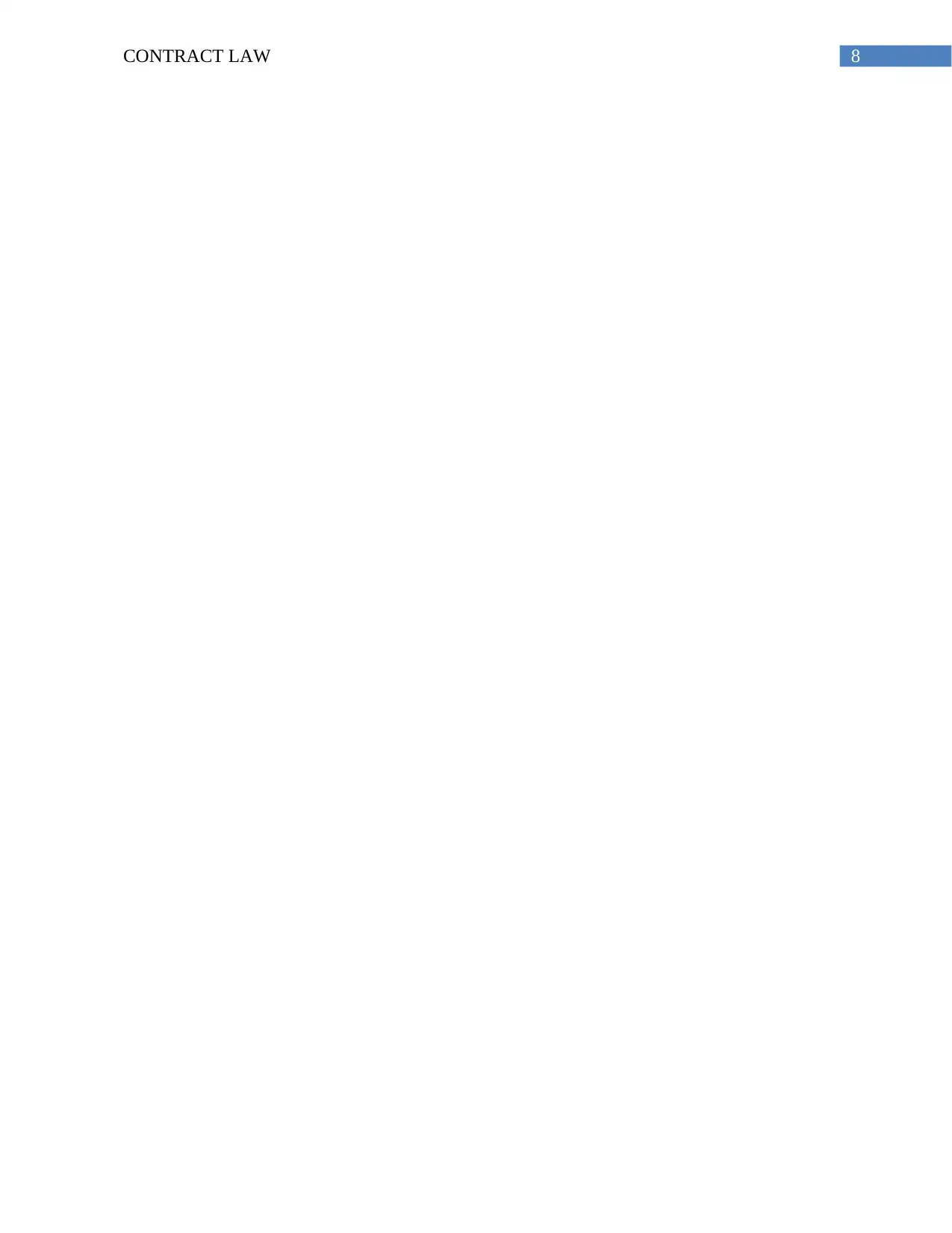
8CONTRACT LAW
⊘ This is a preview!⊘
Do you want full access?
Subscribe today to unlock all pages.

Trusted by 1+ million students worldwide
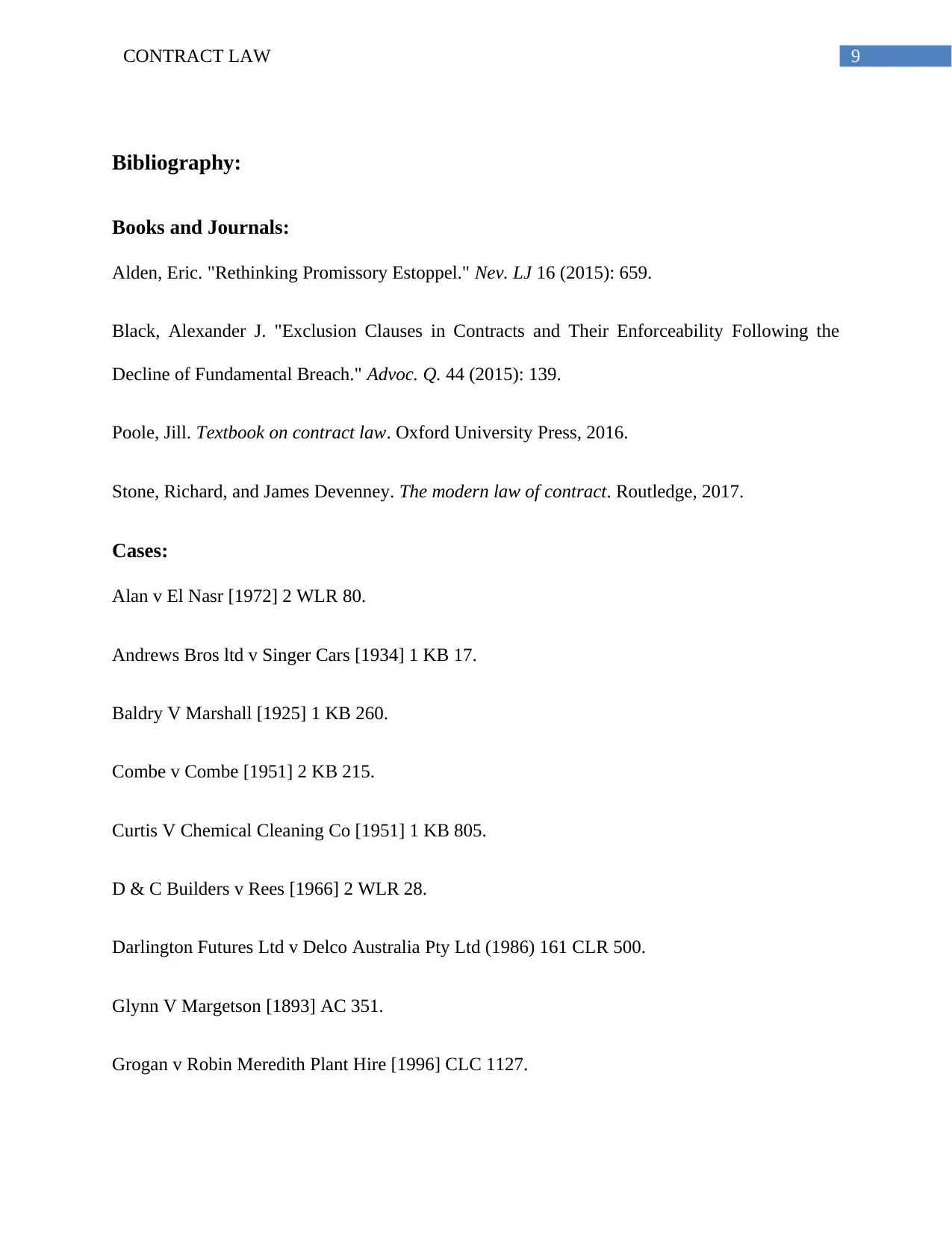
9CONTRACT LAW
Bibliography:
Books and Journals:
Alden, Eric. "Rethinking Promissory Estoppel." Nev. LJ 16 (2015): 659.
Black, Alexander J. "Exclusion Clauses in Contracts and Their Enforceability Following the
Decline of Fundamental Breach." Advoc. Q. 44 (2015): 139.
Poole, Jill. Textbook on contract law. Oxford University Press, 2016.
Stone, Richard, and James Devenney. The modern law of contract. Routledge, 2017.
Cases:
Alan v El Nasr [1972] 2 WLR 80.
Andrews Bros ltd v Singer Cars [1934] 1 KB 17.
Baldry V Marshall [1925] 1 KB 260.
Combe v Combe [1951] 2 KB 215.
Curtis V Chemical Cleaning Co [1951] 1 KB 805.
D & C Builders v Rees [1966] 2 WLR 28.
Darlington Futures Ltd v Delco Australia Pty Ltd (1986) 161 CLR 500.
Glynn V Margetson [1893] AC 351.
Grogan v Robin Meredith Plant Hire [1996] CLC 1127.
Bibliography:
Books and Journals:
Alden, Eric. "Rethinking Promissory Estoppel." Nev. LJ 16 (2015): 659.
Black, Alexander J. "Exclusion Clauses in Contracts and Their Enforceability Following the
Decline of Fundamental Breach." Advoc. Q. 44 (2015): 139.
Poole, Jill. Textbook on contract law. Oxford University Press, 2016.
Stone, Richard, and James Devenney. The modern law of contract. Routledge, 2017.
Cases:
Alan v El Nasr [1972] 2 WLR 80.
Andrews Bros ltd v Singer Cars [1934] 1 KB 17.
Baldry V Marshall [1925] 1 KB 260.
Combe v Combe [1951] 2 KB 215.
Curtis V Chemical Cleaning Co [1951] 1 KB 805.
D & C Builders v Rees [1966] 2 WLR 28.
Darlington Futures Ltd v Delco Australia Pty Ltd (1986) 161 CLR 500.
Glynn V Margetson [1893] AC 351.
Grogan v Robin Meredith Plant Hire [1996] CLC 1127.
Paraphrase This Document
Need a fresh take? Get an instant paraphrase of this document with our AI Paraphraser
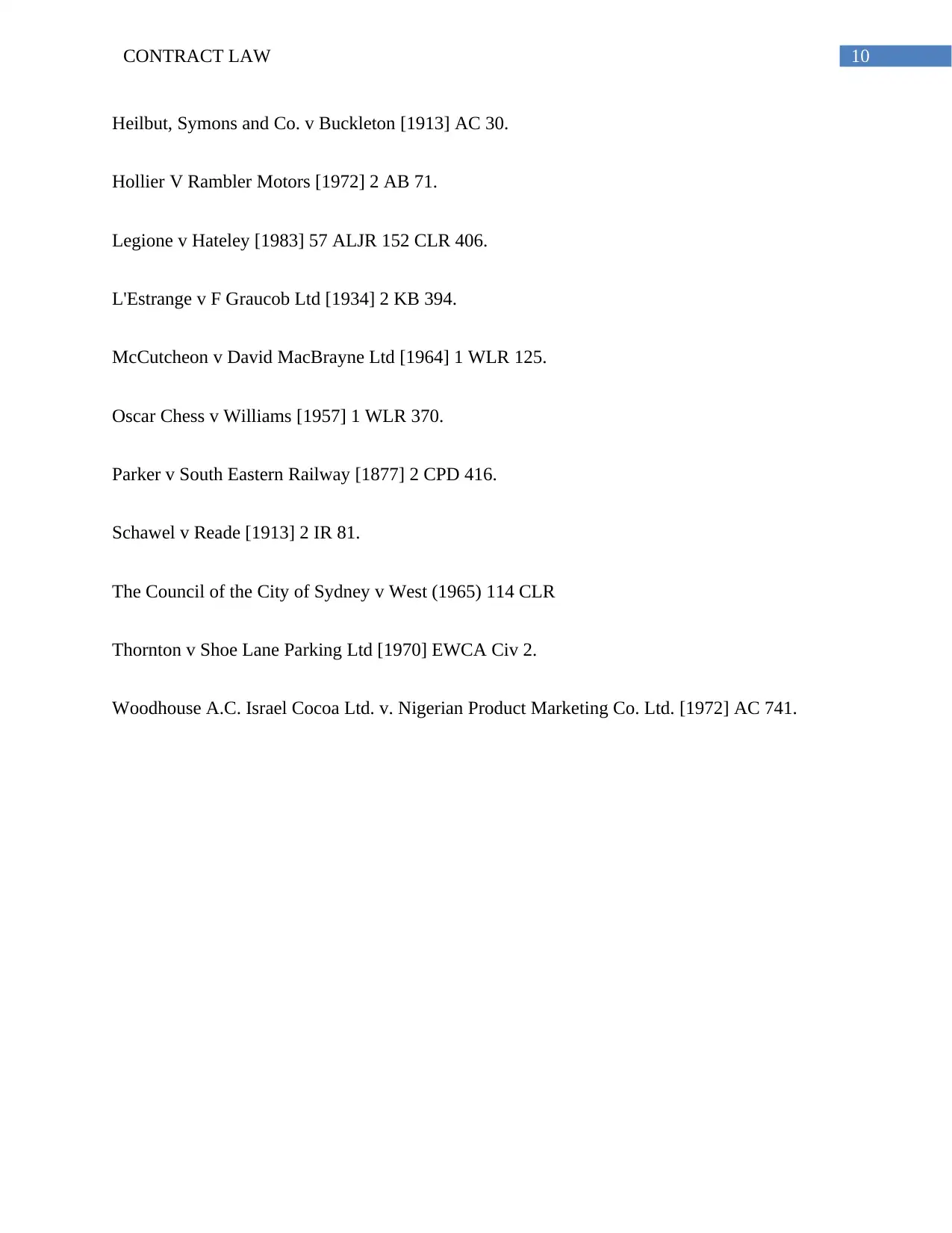
10CONTRACT LAW
Heilbut, Symons and Co. v Buckleton [1913] AC 30.
Hollier V Rambler Motors [1972] 2 AB 71.
Legione v Hateley [1983] 57 ALJR 152 CLR 406.
L'Estrange v F Graucob Ltd [1934] 2 KB 394.
McCutcheon v David MacBrayne Ltd [1964] 1 WLR 125.
Oscar Chess v Williams [1957] 1 WLR 370.
Parker v South Eastern Railway [1877] 2 CPD 416.
Schawel v Reade [1913] 2 IR 81.
The Council of the City of Sydney v West (1965) 114 CLR
Thornton v Shoe Lane Parking Ltd [1970] EWCA Civ 2.
Woodhouse A.C. Israel Cocoa Ltd. v. Nigerian Product Marketing Co. Ltd. [1972] AC 741.
Heilbut, Symons and Co. v Buckleton [1913] AC 30.
Hollier V Rambler Motors [1972] 2 AB 71.
Legione v Hateley [1983] 57 ALJR 152 CLR 406.
L'Estrange v F Graucob Ltd [1934] 2 KB 394.
McCutcheon v David MacBrayne Ltd [1964] 1 WLR 125.
Oscar Chess v Williams [1957] 1 WLR 370.
Parker v South Eastern Railway [1877] 2 CPD 416.
Schawel v Reade [1913] 2 IR 81.
The Council of the City of Sydney v West (1965) 114 CLR
Thornton v Shoe Lane Parking Ltd [1970] EWCA Civ 2.
Woodhouse A.C. Israel Cocoa Ltd. v. Nigerian Product Marketing Co. Ltd. [1972] AC 741.
1 out of 11
Related Documents
Your All-in-One AI-Powered Toolkit for Academic Success.
+13062052269
info@desklib.com
Available 24*7 on WhatsApp / Email
![[object Object]](/_next/static/media/star-bottom.7253800d.svg)
Unlock your academic potential
Copyright © 2020–2025 A2Z Services. All Rights Reserved. Developed and managed by ZUCOL.




![Detailed Case Analysis: Contract Law Issues in Business - [Module]](/_next/image/?url=https%3A%2F%2Fdesklib.com%2Fmedia%2Fimages%2Fbp%2F21fe1e6ab8ee47e1b904ddfd70315544.jpg&w=256&q=75)
